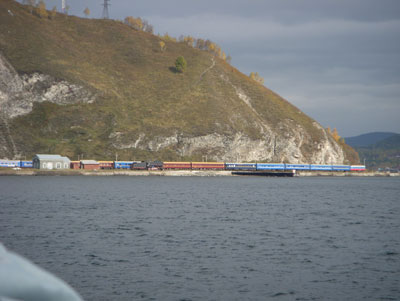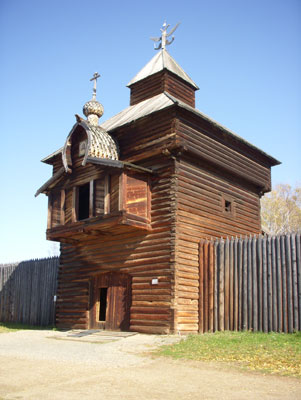Circumbaikal Railroad
This item appears on page 56 of the September 2010 issue.
by Jay Brunhouse (Second of three parts)
After a long, dreamless sleep in my compartment, I parted my curtains and let out a cry of joy to see the peaceful expanse of Lake Baikal, the Pearl of Siberia, the world’s largest sweet-water lake, stretching out of sight.
Fallen green needles and autumn leaves covered the earth with golds and reds, and, brimmed by rose-colored granite cliffs, Baikal appeared like a pool of liquid slate, a wide saucer leaden in the morning chill. A frosting of glistening snow decorated the hills on the opposite shore like a vanilla topping.
Lake Baikal contains one-sixth of all the fresh water in world and is also the oldest lake. Already 5,150 feet deep, it is getting larger and deeper as tectonic plates separate, causing frequent earthquakes. Geologists claim it may become the Earth’s fifth ocean.
Fish story
At 700 to 1,600 feet deep, where the temperature is 38°F, Lake Baikal harbors two kinds of golomianka, weird fish found nowhere else. The larger of the two nearly transparent varieties grows to about eight inches. It has saucer eyes that dominate its head, which is one-third of its length — like the auto insurance lizard.
Every autumn, each female golomianka releases about 2,000 tadpoles instead of laying eggs. When the males and females die, most sink to the bottom. Larger males, however, rise to the surface, where they melt or burst, leaving backbones encased in fat and a pool of oil. Buryats seize the oil to fuel their lamps and also take the golomianka oil (which is vitamin A rich) orally. Those that are not washed ashore are eaten by freshwater Baikal seals, which, in turn, also provide winter fare for the Buryats.
During the night of Sept. 20, 2009, the engineer of our Zarengold Trans-Siberian private train had parked at Port Baikal on the northwest shore. Until the Circumbaikal Loop was completed, Port Baikal was the terminus of train ferries crossing the lake to Mysovaya on the far shore. The contract for the first of the train ferries — which also had to be an icebreaker — was signed in 1895 by Prince Khilkov, the (then) Minister of Ways and Communications.
Icebreaker Baikal
Shipwrights constructed a hull with inch-thick steel plating reinforced with two-foot-thick timber capable of breaking through ice four feet thick. After a year, when the Baikal, as she was later named, was finally completed, she was disassembled and shipped from England to St. Petersburg, where all the components were again divided up, this time into 7,000 separate parcels for journeys across European Russia and Siberia to the lake.
The first parcels began to arrive at Listwanka, a small port across the river from Port Baikal, toward the end of 1897, but piecemeal, so parts of engines turned up before the keel. It was a miracle that nothing of importance was lost.
The Baikal was finally launched in July 1899, almost four years after her keel was first laid in the British yard. By the time she went into service in April 1900, dock facilities had been built for her at Port Baikal and Mysovaya.
No one in Siberia had seen anything like this huge, slab-sided, gleaming white vessel. Another, smaller, vessel, the Angara, had meanwhile been commissioned, and in February 1904, while both ships were ice-bound, the Japanese made their surprise attack on the Russian fleet at Port Arthur, on the Yellow Sea, and it became imperative that military reinforcements and war material be rushed east.
Prince Khilkov ordered that a railroad track using extra-long ties be laid across the ice, which was then five feet thick. Unfortunately, the test engine suddenly plunged through the ice due to unsuspected warm springs below the ice and made a hole almost five feet wide and more than 14 miles long.
After this disaster, men and horses dragged sledges piled high with component parts across the 25-mile expanse.
Circumbaikal
In the meantime, contractors supervised Armenian and Italian laborers and masons working flat out in -40°F temperatures to complete 39 stone-lined tunnels and more than 100 arched bridges and viaducts along the steep, 50-mile cliff section of the Circumbaikal Loop between Port Baikal and Kultuk. In September 1904, they succeeded. The historic railroad to Port Baikal became known as “The Czar’s Jeweled Buckle.”
When the Angara River was dammed in the 1950s, Lake Baikal rose about 20 feet and submerged part of the Circumbaikal Line. A modern shortcut was built to complete the Trans-Siberian mainline and the remaining Circumbaikal section became redundant. Now Port Baikal is a collection of weather-worn harbor buildings at a dead end of a rarely used branch line.
Excursion on Lake Baikal
After breakfast, we boarded the Babushkin for a sunny sightseeing cruise on the lake. The views of the cliffs, mountains and shorelines were magnificent, but the breath of winter was chilling.
Back aboard the Zarengold for lunch, our train took us to “Km 110” for an opportunity to bathe in the lake or visit the village. Several hearty passengers took a dip in the lake and reported that the water wasn’t so cold after all. Chugging again to Marituij, another Baikal village, the staff prepared a rich and delicious barbecue beside the train, but, again, winter winds were chilling.
In the morning, a bus took us to the Baikal village of Listwanka, where contractors had reassembled the Baikal. We then visited the Taltsy outdoor museum of preserved wooden structures, where the 17th-century Iliminsk Ostrog watchtower dominated the enclosure. The striking centerpiece was an Orthodox church. The watchtower, the church, two chapels and a water mill gave me a strong impression for the building styles and life of the early East Siberian Buryats and Russian exiles.
The next day, we would visit Irkutsk, also known as the Paris of Siberia, and then get to know ever-larger cities as we crossed Siberia and European Russia to Moscow, the City of Golden Domes. All Aboard! Till next time.
I thank Lernidee Tours of Berlin, Germany (www.lernidee.de/en), for inviting me aboard the Zarengold Trans-Siberian private train. For more information, contact Bjarne “BJ” Mikkelsen, The Cruise Broker (New York, NY; phone 917/282-2305 or e-mail [email protected]). BJ represents Lernidee Tours in North America.


